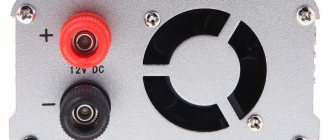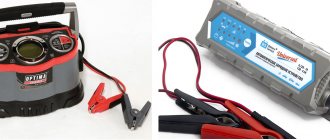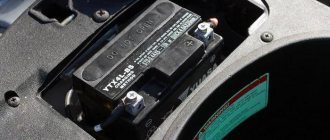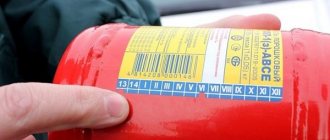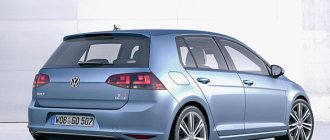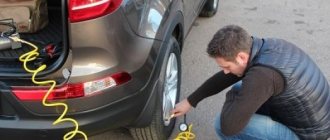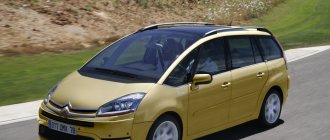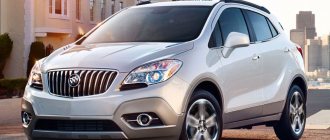AGM battery technology
AGM stands for Absorbent Glass Mat and means “absorbent glass fiber”. In fact, these are ordinary lead-acid batteries, only in them the electrolyte is not in the form of a freely flowing liquid, but in the form of glass wool abundantly soaked in a solution of sulfuric acid (a kind of diaper for electrolyte). What does it give:
- There is a place for the hydrogen released during the charging process - it is “locked” in the fiberglass. In other words, the gas is completely recombined inside the battery. This allows you to safely use AGM batteries indoors.
- Sealed design allows them to be used in any position
- They do not require maintenance, but this does not eliminate the need for periodic “training” of batteries
AGM technology
Especially for our readers, we did not regret and sawed up the popular CSB GP 12120 battery, let's see what's inside:
Cutting CSB GP 12120
Lead plates with absorbed glass wool electrolyte
AGM itself is richly impregnated with electrolyte
Lead plate
Do you really need such a battery?
So, it is worth noting a significant disadvantage of this type of device. They can only be used in cars with a very precise charging mechanism. An ideally working relay-regulator in both domestic and foreign cars maintains a voltage within 13–16 volts, and for recharging this battery, a voltage above 14.4 volts is detrimental. The gel simply melts and the reverse process cannot be achieved. In addition, severe frost is also unacceptable, because the gel hardens, losing its characteristics and immediately becoming 2 times less powerful.
Gel technology
The design of a gel battery is similar to AGM, but the electrolyte is not absorbed by glass fiber, but thickened with silica gel (SiO2). The gel retains the electrolyte in its structure, maintaining the integrity of the lead plates. The movement of electrolyte molecules occurs through the micropores of the gel structure.
Now let's compare the characteristics and cost of similar batteries made using different technologies. Based on data sheets (performance characteristics) and an interview with an engineer, we will compare the characteristics using the example of Delta and Challenger batteries.
1) Charge
The classic charge current for lead-acid batteries is 0.1C or 10% of the battery capacity, but the maximum permissible charge current for AGM and gel batteries is different:
- AGM – 0.3C (for example, for battery Delta HR 12-100 (100Ah) – charge current 30A)
- GEL – 0.2C (for battery Delta GX 12-100 (100Ah) – charge current 20A)
Charging with maximum current slightly reduces the battery life (by 5-7%), but can be very useful in cases where the battery needs to be charged quickly. For example, when working in hybrid systems with a generator. Thus, the minimum possible charging time (taking into account efficiency) for a completely depleted AGM battery will be about 6 hours, and for a GEL battery – 8 hours.
2) Number of cycles
Let's compare the number of cycles for different types of batteries in two different series
Delta HR 12-100 (AGM) : 100% DOD - 275 cycles, 50% - 575 cycles, 30% - 1325 cycles
Delta GX 12-100 (GEL): 100% – 325 cycles, 50% – 700 cycles, 30% – 1850 cycles
Delta DTM 12-200 L (AGM): 100% – 275 cycles, 50% – 550 cycles, 30% – 1200 cycles
Delta GX 12-200 (GEL): 100% – 325 cycles, 50% – 700 cycles, 30% – 1850 cycles
So, the difference in cyclicity between the HR (AGM) and GX (GEL) series at DOD 50% is 21.7% in favor of the latter; between DTM and GX: 27.2% in favor of the latter.
For objectivity, we present a graph and data on Challenger batteries series A (AGM) and G (GEL) at a discharge of up to 80%
Challenger A12-200 – 80% DOD – 525 cycles Challenger G12-200 – 80% DOD – 645 cycles 19% difference.
3) Current retail price and cycle cost
Due to the unstable exchange rate, I had to indicate in the hated dollars. In relation to the number of cycles at 50% discharge:
- Delta HR 12-100 – $223/575=0.406
- Delta GX 12-100 – $240/700=0.343
- Delta DTM 12200 L – $390/550=0.709
- Delta GX 12-200 – $467/700=0.667
For Challenger:
- Challenger A12-200 – $475/525=0.91
- Challenger G12-200 – $550/645=0.85
4) Deep discharge
Thanks to the use of an electrolyte thickener, a gel battery is more resistant to deep discharges, in other words, a discharge up to 1.6V/el (9.6V) causes less harm to the battery. Deep discharge of batteries is inherent in alternative energy (solar panels, wind turbines); in buffer modes, UPSs and inverters do not allow the battery to discharge below 10.5V.
5) Lifespan
The lifespan of a battery is a relatively abstract thing due to the fact that it is difficult and costly to conduct a professional study with parallel operation of a sample of two types of batteries from different series lasting 10-12 years and compare its results. The documentation indicates the same battery life. In view of this, we must rely on indirect data that is given to us by production engineers, whose opinion is based on the features of manufacturing technologies. So:
- DTM – standard AGM battery
- HR and HRL - differ in the composition of the electrolyte, to which special additives have been added, which increase energy output and slow down the process of sulfation and corrosion of the lead plates of the battery, significantly extending its service life
- Gel – electrolyte thickened with silica gel
Based on a survey of experts, the rating of the viability and timing of work in the buffer mode, from least to greatest, is built as follows:
- GX – a guide to cyclicality
- DTM L – Long Life additives
- HR – additives + high energy efficiency
Choosing a car battery, differences, nuances
In order to find out which batteries will be the best option for your car model, the car owner will have to perform a number of actions that are of considerable importance in determining those parameters that will be truly important.
Batteries for cars and trucks are characterized by the following parameters:
- The level of rated capacity, which represents the ability to release energy without interruption for 20 hours. In order to determine it, the battery is continuously discharged at 25 degrees, since this is the indicator indicated on the label;
- Reserve capacity. The ability of a car battery to continuously supply energy without using a generator;
- Starting power. The maximum level of output power that the battery can produce at 18 degrees for a time period of 30 seconds. For European countries, this time period is significantly shorter and amounts to 10 seconds;
- Polarity is the arrangement of the battery contacts. The choice of terminals is of great importance, taking into account the fact that the length of the power cables may be short;
- Device weight;
- Dimensions.
After assessing the characteristics, the owner determines which battery will be the best option and which batteries should be discarded.
conclusions
- AGM batteries have an advantage in systems that require fast charging of batteries, for example, in the case of hybrid “inverter + generator” circuits (we reduce the operating time of the generator and increase the silence time), because withstand higher charging current.
- In the case of solving the problem of autonomous power supply based on solar panels or a wind generator, if the budget is sufficient, gel batteries are preferable, since they are resistant to deep discharge and have a longer charge-discharge cycle life.
- To work in buffer mode, i.e. in backup power systems based on UPS and inverters, preference should be given to AGM technology, because the battery bank is cheaper and will last longer (the life of batteries in buffer mode is calculated in years, not in cycles). The most durable series of HR and HRL batteries thanks to various additives in the electrolyte that reduce the destruction of lead plates.
- In powerful systems with high discharge currents and autonomy of up to 30 minutes, the use of the HR and HRL series is recommended, because These batteries have the highest energy output per unit time with short cycles.
Charging the gel battery
In order for the gel battery to be charged correctly and safely, it is better not to use any home methods and not to skimp on a good and reliable charger. As already mentioned, such batteries are very demanding in terms of charging current. The recommended charge current is 10% of the nominal battery capacity. To ensure exactly this condition throughout the entire charge cycle, you need to purchase a power supply or charger with adjustable voltage and current . Jumps in these parameters during charging are unacceptable.
To charge the gel battery, you need:
- plug in the charger;
- set the voltage parameters indicated on the battery case (on average, 14 V or so);
- be sure to reduce the current to zero;
- connect the battery to the charger, observing the polarity - “minus” to “minus”, and “plus” to “plus”;
- gradually increase the current (it should be no more than 10% of the battery capacity);
- important: as charging approaches its end, the voltage will increase and the current will drop - this means that the battery is charging correctly;
- at the end of charging, the current indicator can be a scanty 100 mA.
Read about how to restore a gel battery here →
If your financial capabilities allow you to purchase a gel battery, subject to certain rules for its operation, it will justify its cost and even the purchase of an additional relay. It is important to know the specifics of batteries of this type and not to treat them too carelessly, despite their “maintenance-free” nature, the presence of which does not negate a careful and attentive attitude towards batteries of any type.
Tips for choosing a good battery
Car owners often have a question about which type of battery is the best - lead-acid, gel or AGM. All of these types have their own positive and negative sides, which makes the final choice very difficult.
There is no such thing as the “best battery”. If it is necessary to choose a specific model, it is best to ensure a competent balance of the characteristics of the choice.
Advantages of an AGM battery:
- Sealed design and the ability to adjust the valves, which prevents the threat of acid leakage and signs of corrosion;
- Ensuring safety during work - there is no threat of explosion or release of highly toxic substances;
- High degree of discharge magnitude;
- Good tolerance to low temperatures and demonstration of stable operation;
- Charging in a short period of time;
- High degree of vibration resistance.
Gel batteries have the following positive aspects:
- No possibility of electrolyte leakage;
- Vibration resistance;
- Reliability and durability;
- Stable operation in the temperature range from minus 350 to 550 degrees;
- Allowance for short-term overdischarge;
- These are one of the most durable batteries for cars - their service life is almost twice as long as similar ones;
- The electrolyte does not evaporate;
- Same operation in both starter and rotation modes.
But they also have negative sides, since even reliable brands of batteries have them. For AGM batteries this will be a strong reaction to the increased charge due to the small volume of electrolyte. Gel batteries, on the other hand, have disadvantages such as lower load characteristics and increased demands during charging.
From all of the above, we can conclude that the most durable batteries are gel ones. But this advantage is offset by the high price.
The agony of choice: which battery is better to take - EFB or AGM and why
The AGM product has a high starting current and fast charging. The counterbalance to the EFB is only in price - 3,000 rubles difference. Improved “liquid” technology is only able to compete with traditional manufacturing methods. Hence, there are various areas of purpose for progressive batteries.
Manufacturers' recommendations
The classic advice “install the same as from the factory” is always relevant - you can’t go wrong. Automakers are based on the load and recharging technology implemented by the on-board electrical network:
- EFB – vehicles with the “Start-Stop” function.
- AGM – cars with regenerative braking.
Interchangeability
- The improved liquid battery can be replaced with an AGM. Replacement in the reverse order is allowed for a short time: liquid feeders take up charge slowly and the method of recharging the EFB battery from a network device will have to be used much more often.
- Instead of a traditional battery, you can install an ESF. It will last longer both in a single autonomous mode and in the long term.
- It is unjustified to install AGM instead of a conventional battery without increasing the load. You won’t be able to save on Amp-hours; high starting currents are only needed in severe frosts, and intensive charge restoration is an option that is certainly necessary, but not at such a price. It’s better to buy a simple battery and a good quality automatic charger, and take care of the device.
Individual cases
Nanotechnology is not without its vagaries: the AGM battery is better than its EFB class opponent in terms of electrical parameters, but has special requirements for maintenance and the workplace. 10 years, which is 3 years longer than the average service life of the EFB. During this period, a product based on absorbed electrolyte is guaranteed to work, but subject to:
- Mounted away from the engine.
- Exceptions to periods of storage in a discharged state.
Any increase in the load on the on-board network beyond the norm is stressful for the battery. A standard battery will not tolerate powerful acoustics or pre-heater of any system. If an EFB is installed, feel free to switch to AGM, a simple one - also to AGM, AGM - to a more capacious analogue. Any “liquid” alternative also does not resist sulfation, but the temperature factor is not so critical.
Good advice: stable energy supply to several consumers at once is typical only for a product with absorbed liquid. The numbers confirm this. When connecting a 1.5 kW speaker amplifier at the same volume, the voltage at the AGM terminals is 0.3-0.5 V higher than that of the EFB. And the first one is restored in 5 minutes of idling, and the second one in 15-20 minutes of driving.
Characteristic Misconception
Returning to AGM batteries, we note that many car enthusiasts often make the mistake of associating this term with such a popular concept as “gel” batteries. Let us clarify: gel batteries are not widely used in passenger cars as starter sources of on-board power! The vast majority of gel batteries, in which the electrolyte is in a jelly-like state, are used only as traction batteries. True, not everyone knows about this, and some don’t even want to know. By the way, sometimes you have to observe how sellers of individual retail outlets, in order not to dissuade “smart” customers, deliberately replace the abbreviation AGM with the word “gel” on store price tags. Like, since people think so, why force a different opinion on them? The main thing is that the client is confident that he is right and remains satisfied with the purchase.
